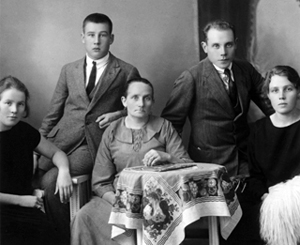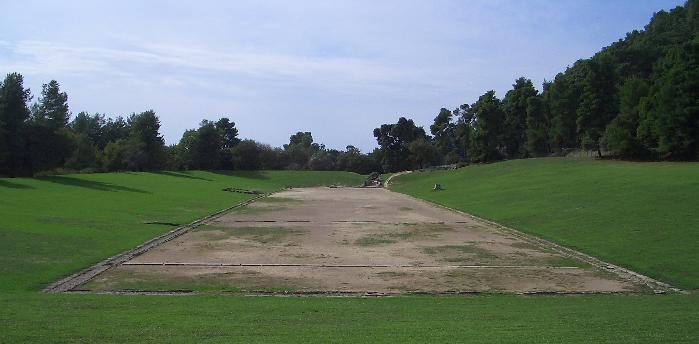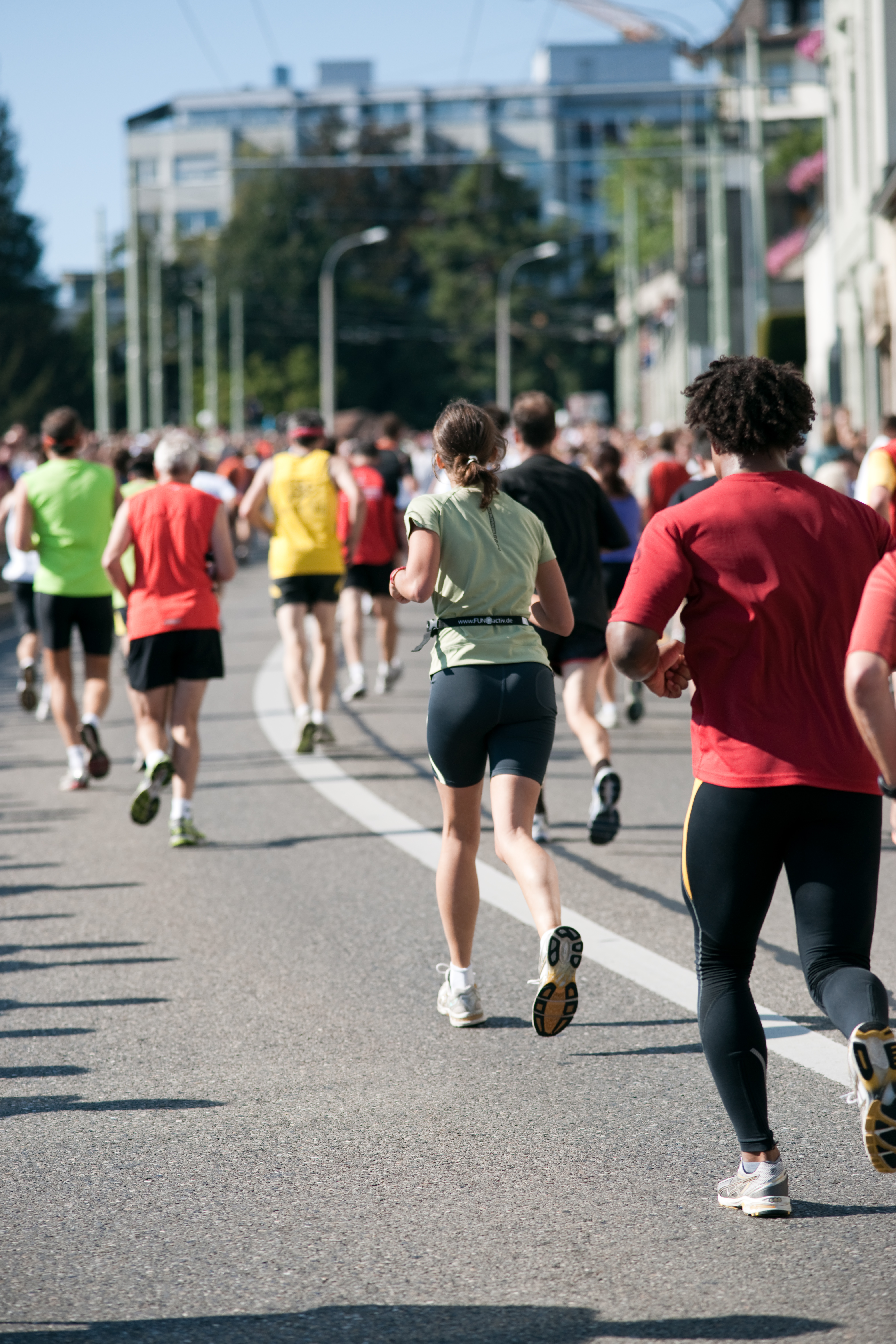|
Paavo Nurmi
Paavo Johannes Nurmi (; 13 June 1897 – 2 October 1973) was a Finnish middle-distance and long-distance runner. He was called the "Flying Finn" or the "Phantom Finn", as he dominated distance running in the 1920s. Nurmi set 22 official world records at distances between 1500 metres and 20 kilometres, and won nine gold and three silver medals in his 12 events in the Summer Olympic Games. At his peak, Nurmi was undefeated for 121 races at distances from 800 m upwards. Throughout his 14-year career, he remained unbeaten in cross country events and the 10,000 metres. Born into a working-class family, Nurmi left school at the age of 12 to provide for his family. In 1912, he was inspired by the Olympic feats of Hannes Kolehmainen and began developing a strict training program. Nurmi started to flourish during his military service, setting Finnish records in athletics en route to his international debut at the 1920 Summer Olympics. After winning a silver medal in the 5000 m, he ... [...More Info...] [...Related Items...] OR: [Wikipedia] [Google] [Baidu] |
1920 Summer Olympics
The 1920 Summer Olympics (french: Jeux olympiques d'été de 1920; nl, Olympische Zomerspelen van 1920; german: Olympische Sommerspiele 1920), officially known as the Games of the VII Olympiad (french: Jeux de la VIIe olympiade; nl, Spelen van de VIIe Olympiade; german: Spiele der VII. Olympiade) and commonly known as Antwerp 1920 (french: Anvers 1920; Dutch and German: ''Antwerpen 1920''), were an international multi-sport event held in 1920 in Antwerp, Belgium. In March 1912, during the 13th session of the IOC, Belgium's bid to host the 1920 Summer Olympics was made by Baron Édouard de Laveleye, president of the Belgian Olympic Committee and of the Royal Belgian Football Association. No fixed host city was proposed at the time. The 1916 Summer Olympics, to have been held in Berlin, capital of the German Empire, were cancelled due to World War I. When the Olympic Games resumed after the war, Antwerp was awarded hosting the 1920 Summer Games as tribute to the Belgian people. ... [...More Info...] [...Related Items...] OR: [Wikipedia] [Google] [Baidu] |
Athletics At The 1920 Summer Olympics – Men's 5000 Metres
The men's 5000 metres event was part of the track and field athletics programme at the 1920 Summer Olympics. The competition was held on Monday, August 16, 1920, and on Tuesday, August 17, 1920. Thirty-eight runners from 16 nations competed. Competition format The competition consisted of two rounds. First four semifinals were held of 9 to 10 runners with the top four in each heat advancing. The final race was then held the next day with 16 competitors. Records These were the standing world and Olympic records (in minutes) prior to the 1920 Summer Olympics. Schedule Results Semifinals Semifinal 1 Semifinal 2 Semifinal 3 Semifinal 4 Final References Notes * * {{DEFAULTSORT:Athletics At The 1920 Summer Olympics - Men's 5000 Metres 5000 metres The 5000 metres or 5000-metre run is a common long-distance running event in track and field, approximately equivalent to or . It is one of the track events in the Olympic Games and the World Championship ... [...More Info...] [...Related Items...] OR: [Wikipedia] [Google] [Baidu] |
Hannes Kolehmainen
Juho Pietari "Hannes" Kolehmainen (; 9 December 1889 – 11 January 1966) was a Finnish four-time Olympic Gold medalist and a world record holder in middle- and long-distance running. He was the first in a generation of great Finnish long-distance runners, often named the "Flying Finns". Kolehmainen competed for a number of years in the United States, wearing the Winged Fist of the Irish American Athletic Club. He also enlisted in the 14th Regiment of the National Guard of New York, and became a U.S. citizen in 1921. Biography Kolehmainen, a devoted vegetarian and bricklayer by trade, was from a sportive family from Kuopio – his brothers William and Tatu were also strong long-distance runners. Tatu competed in two Olympics and finished 10th in the Marathon in 1920. Hannes was one of the stars of the 1912 Summer Olympics in Stockholm, winning three gold medals. His most memorable was the one in the 5000 m. In that event, he ran a heroic duel with Frenchman Jean Bouin. Aft ... [...More Info...] [...Related Items...] OR: [Wikipedia] [Google] [Baidu] |
10,000 Metres
The 10,000 metres or the 10,000-metre run is a common long-distance track running event. The event is part of the athletics programme at the Olympic Games and the World Athletics Championships, and is common at championship level events. The race consists of 25 laps around an Olympic-sized track. It is less commonly held at track and field meetings, due to its duration. The 10,000-metre track race is usually distinguished from its road running counterpart, the 10K run, by its reference to the distance in metres rather than kilometres. The 10,000 metres is the longest standard track event, approximately equivalent to or . Most of those running such races also compete in road races and cross country events. Added to the Olympic programme in 1912, athletes from Finland, nicknamed the "Flying Finns", dominated the event until the late 1940s. In the 1960s, African runners began to come to the fore. In 1988, the women's competition debuted in the Olympic Games. Official records ar ... [...More Info...] [...Related Items...] OR: [Wikipedia] [Google] [Baidu] |
800 M
The 800 metres, or meters ( US spelling), is a common track running event. It is the shortest commonly run middle-distance running event. The 800 metres is run over two laps of an outdoor (400-metre) track and has been an Olympic event since the first modern games in 1896. During the winter track season the event is usually run by completing four laps of an indoor 200-metre track. The event was derived from the imperial measurement of a half mile (880 yards), a traditional English racing distance. 800m is 4.67m less than a half mile. The event combines aerobic endurance with anaerobic conditioning and sprint speed, so the 800m athlete has to combine training for both. Runners in this event are occasionally fast enough to also compete in the 400 metres but more commonly have enough endurance to 'double up' in the 1500m. Only Alberto Juantorena and Jarmila Kratochvílová have won major international titles at 400m and 800m. Race tactics The 800m is also known for its tactical ... [...More Info...] [...Related Items...] OR: [Wikipedia] [Google] [Baidu] |
Olympic Games
The modern Olympic Games or Olympics (french: link=no, Jeux olympiques) are the leading international sporting events featuring summer and winter sports competitions in which thousands of athletes from around the world participate in a variety of competitions. The Olympic Games are considered the world's foremost sports competition with more than 200 teams, representing sovereign states and territories, participating. The Olympic Games are normally held every four years, and since 1994, have alternated between the Summer and Winter Olympics every two years during the four-year period. Their creation was inspired by the ancient Olympic Games (), held in Olympia, Greece from the 8th century BC to the 4th century AD. Baron Pierre de Coubertin founded the International Olympic Committee (IOC) in 1894, leading to the first modern Games in Athens in 1896. The IOC is the governing body of the Olympic Movement (which encompasses all entities and individuals involved in the Oly ... [...More Info...] [...Related Items...] OR: [Wikipedia] [Google] [Baidu] |
Silver Medal
A silver medal in sports and other similar areas involving competition is a medal made of, or plated with, silver awarded to the second-place finisher, or runner-up, of contests or competitions such as the Olympic Games, Commonwealth Games, etc. The outright winner receives a gold medal and the third place a bronze medal. More generally, silver is traditionally a metal sometimes used for all types of high-quality medals, including artistic ones. Sports Olympic Games During the first Olympic event in 1896, number one achievers or winners' medals were in fact made of silver metal. The custom of gold-silver- bronze for the first three places dates from the 1904 games and has been copied for many other sporting events. Minting the medals is the responsibility of the host city. From 1928 to 1968 the design was always the same: the obverse showed a generic design by Florentine artist Giuseppe Cassioli with text giving the host city; the reverse showed another generic design ... [...More Info...] [...Related Items...] OR: [Wikipedia] [Google] [Baidu] |
Gold Medal
A gold medal is a medal awarded for highest achievement in a non-military field. Its name derives from the use of at least a fraction of gold in form of plating or alloying in its manufacture. Since the eighteenth century, gold medals have been awarded in the arts, for example, by the Royal Danish Academy of Fine Arts, usually as a symbol of an award to give an outstanding student some financial freedom. Others offer only the prestige of the award. Many organizations now award gold medals either annually or extraordinarily, including various academic societies. While some gold medals are solid gold, others are gold-plated or silver-gilt, like those of the Olympic Games, the Lorentz Medal, the United States Congressional Gold Medal and the Nobel Prize medal. Nobel Prize medals consist of 18 karat green gold plated with 24 karat gold. Before 1980 they were struck in 23 karat gold. Military origins Before the establishment of standard military awards, e.g., the Medal of Honor, ... [...More Info...] [...Related Items...] OR: [Wikipedia] [Google] [Baidu] |
1500 Metres
The 1500 metres or 1,500-metre run (typically pronounced 'fifteen-hundred metres') is the foremost middle distance track event in athletics. The distance has been contested at the Summer Olympics since 1896 and the World Championships in Athletics since 1983. It is equivalent to 1.5 kilometers or approximately miles. The event is closely associated with its slightly longer cousin, the mile race, from which it derives its nickname "the metric mile". The demands of the race are similar to that of the 800 metres, but with a slightly higher emphasis on aerobic endurance and a slightly lower sprint speed requirement. The 1500 metre race is predominantly aerobic, but anaerobic conditioning is also required. Each lap run during the world-record race run by Hicham El Guerrouj of Morocco in 1998 in Rome, Italy averaged just under 55 seconds (or under 13.8 seconds per 100 metres). 1,500 metres is three and three-quarter laps around a 400-metre track. During the 1970s and ... [...More Info...] [...Related Items...] OR: [Wikipedia] [Google] [Baidu] |
List Of World Records In Athletics
World records in athletics are ratified by World Athletics. Athletics records comprise the best performances in the sports of track and field, road running and racewalking. Records are kept for all events contested at the Olympic Games and some others. Unofficial records for some other events are kept by track and field statisticians. The only non-metric track distance for which official records are kept is the mile run. Criteria The criteria which must be satisfied for ratification of a world record are defined by World Athletics in Part III of the Competition Rules. These criteria also apply to national or other restricted records and also to performances submitted as qualifying marks for eligibility to compete in major events such as the Olympic Games. The criteria include: * The dimensions of the track and equipment used must conform to standards. In road events, the course must be accurately measured, by a certified measurer. * Except in road events (road running and race ... [...More Info...] [...Related Items...] OR: [Wikipedia] [Google] [Baidu] |
Flying Finn
"The Flying Finn" ( fi, Lentävä suomalainen, sv, Flygande finländaren) is a nickname given to several Finnish athletes who were noted for their speed. Originally, it was given to several Finnish middle and long-distance runners. The term was later extended to notable Finnish racing drivers. ''Flying Finn'' is also the title of a documentary about the history of sports in Finland, and is the first English-language documentary produced in Finland. Running The nickname was first used of Hannes Kolehmainen, also known as ''"Smiling Hannes"'', as he took home three gold medals and broke two world records during the 1912 Summer Olympics in Stockholm. As Finnish runners started to dominate long-distance running, the nickname was passed on to all successful Finns in the sport, including multi-Olympic gold medalists Paavo Nurmi and Ville Ritola. Nurmi won three gold medals at the 1920 Summer Olympics in Belgium and five at the 1924 Summer Olympics in Paris, where he was partnered wit ... [...More Info...] [...Related Items...] OR: [Wikipedia] [Google] [Baidu] |
Long-distance Running
Long-distance running, or endurance running, is a form of continuous running over distances of at least . Physiologically, it is largely aerobic in nature and requires stamina as well as mental strength. Within endurance running comes two different types of respiration. The more prominent side that runners experience more frequently is aerobic respiration. This occurs when oxygen is present, and the body is able to utilize oxygen to help generate energy and muscle activity. On the other side, anaerobic respiration occurs when the body is deprived of oxygen, and this is common towards the final stretch of races when there is a drive to speed up to a greater intensity. Overall, both types of respiration are used by endurance runners quite often, but are very different from each other. Among mammals, humans are well adapted for running significant distances, and particularly so among primates. The capacity for endurance running is also found in migratory ungulates and a li ... [...More Info...] [...Related Items...] OR: [Wikipedia] [Google] [Baidu] |





.jpg)
